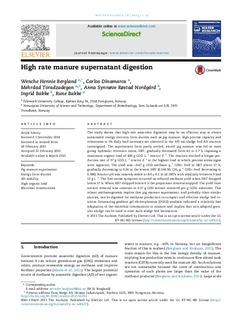| dc.contributor.author | Bergland, Wenche Hennie | |
| dc.contributor.author | Dinamarca, Carlos | |
| dc.contributor.author | Toradzadegan, Mehrdad | |
| dc.contributor.author | Nordgård, Anna Synnøve Røstad | |
| dc.contributor.author | Bakke, Ingrid | |
| dc.contributor.author | Bakke, Rune | |
| dc.date.accessioned | 2018-01-08T13:24:55Z | |
| dc.date.available | 2018-01-08T13:24:55Z | |
| dc.date.created | 2015-03-06T09:06:13Z | |
| dc.date.issued | 2015 | |
| dc.identifier.citation | Water Research. 2015, 76 1-9. | nb_NO |
| dc.identifier.issn | 0043-1354 | |
| dc.identifier.uri | http://hdl.handle.net/11250/2476276 | |
| dc.description.abstract | The study shows that high rate anaerobic digestion may be an efficient way to obtain sustainable energy recovery from slurries such as pig manure. High process capacity and robustness to 5 % daily load increases are observed in the 370 ml sludge bed AD reactors investigated. The supernatant from partly settled, stored pig manure was fed at rates giving hydraulic retention times, HRT, gradually decreased from 42 to 1.7 hours imposing a maximum organic load of 400 g COD L-1 reactor d-1. The reactors reached a biogas production rate of 97 g COD L-1 reactor d-1 at the highest load at which process stress signs were apparent. The yield was ∼0.47 g COD methane g-1 CODT feed at HRT above 17 h, gradually decreasing to 0.24 at the lowest HRT (0.166 NL CH4 g-1 CODT feed decreasing to 0.086). Reactor pH was innately stable at 8.0 ± 0.1 at all HRTs with alkalinity between 9-11 g L-1. The first stress symptom occurred as reduced methane yield when HRT dropped below 17 h. When HRT dropped below 4 h the propionate removal stopped. The yield from acetate removal was constant at 0.17 g COD acetate removed per g CODT substrate. This robust methanogenesis implies that pig manure supernatant, and probably other similar slurries, can be digested for methane production in compact and effective sludge bed reactors. Denaturing gradient gel electrophoresis (DGGE) analysis indicated a relatively fast adaptation of the microbial communities to manure and implies that non-adapted granular sludge can be used to start such sludge bed bioreactors. | nb_NO |
| dc.language.iso | eng | nb_NO |
| dc.relation.uri | http://www.sciencedirect.com/science/article/pii/S0043135415001244# | |
| dc.rights | Attribution-NonCommercial-NoDerivatives 4.0 Internasjonal | * |
| dc.rights.uri | http://creativecommons.org/licenses/by-nc-nd/4.0/deed.no | * |
| dc.title | High rate manure supernatant digestion | nb_NO |
| dc.type | Journal article | nb_NO |
| dc.type | Peer reviewed | nb_NO |
| dc.description.version | publishedVersion | nb_NO |
| dc.source.pagenumber | 1-9 | nb_NO |
| dc.source.volume | 76 | nb_NO |
| dc.source.journal | Water Research | nb_NO |
| dc.identifier.doi | 10.1016/j.watres.2015.02.051 | |
| dc.identifier.cristin | 1229876 | |
| cristin.unitcode | 222,58,3,0 | |
| cristin.unitname | Institutt for prosess-, energi- og miljøteknologi | |
| cristin.ispublished | true | |
| cristin.fulltext | original | |
| cristin.qualitycode | 2 | |

